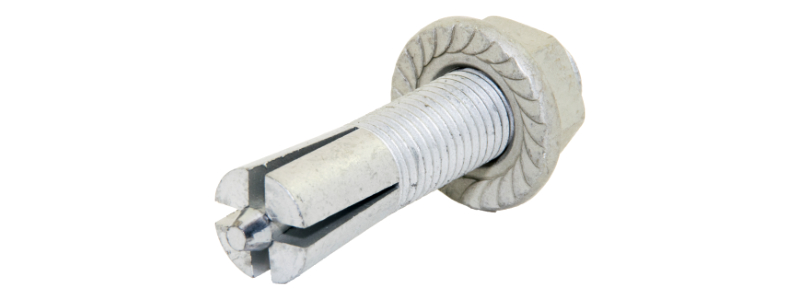Blind Fixings to Steelwork: What Are the Options?
Blindbolt UK | 21st October 2021

Blind Fixing
When Are Blind Fixings Needed?
The obvious answer is when access is only possible from one side. Common situations are for connections to hollow sections and to other fabricated closed profiles. Sometimes, access to both sides of a joint is impractical, uneconomic or involves risks that could be avoided with access from one side only. An example of this would be the fixing of mullions to perimeter steelwork, where access from one side only reduces the access requirements and manpower needed to facilitate access from both sides.
Blind Fixing Options: Tapped Holes And “Captive” Nuts
Three options are generally considered for blind connections, including tapped holes, welding “captive” nuts and bespoke fixings specially designed for blind fixing from one side only.
Tapped holes involve drilling an initial hole and then tapping a thread to receive an ordinary bolt. Structurally, the resistance of a bolt in a tapped hole is uncertain, especially in tension, because of the difference in material strength. A nut for structural applications will generally be at least Property Class 8.8, which means it has an ultimate strength of 800 N/mm2 and a yield strength of 640 N/mm2. In contrast, S355 steel has an ultimate strength of 470 N/mm2 and a yield strength of 355 N/mm2. The combination of nut and bolt are designed to prevent thread stripping in the nut, which is a failure mode more likely in tapped holes in the weaker plate material. Thread stripping is a complex behaviour that is not necessarily resolved by increasing the depth of the threads in the tapped holes to compensate for the reduced material strength.
“Captive” nuts are welded to the inaccessible side of the joint during fabrication. The welding process exposes the nut to a very high temperature locally, melting part of the nut. As the nut is heated and then cools, the structure of the material is changed and its properties can no longer be guaranteed. Welding also risks deforming the nut, so the engagement with the bolt may be affected. Welding of bolts and nuts is prohibited unless otherwise specified, according to BS EN 1090-2.
A further consideration with tapped holes and captive nuts is that on one side of the joint, there is no tolerance. Tolerance may be provided on the connecting plate, but bolts must be inserted in precise locations to engage.
Although tapped holes or welded captive nuts are not recommended for bolts in tension, the solutions may be considered appropriate for a joint loaded in pure shear, since the fasteners are working as dowels. Joints made with either type of fixing can be dismantled.
Bespoke Assemblies for Blind Fixings
Several manufacturers offer special fixings for connections with access from one side only. Some, such as Hollo-Bolt and Box Bolts, use legs that deform on the blind side of the joint (typically inside a hollow section) as the bolt is tightened. During tightening, a conical nut forces the legs to splay to provide resistance to pull-out.
Other fixings, such as Blind Bolt, use a gravity-operated anchor toggle which initially sits within a machined slot in the shank of the bolt. When the bolt is rotated, the anchor rotates into position and allows the fixing to be tightened.
Hollo-Bolts and Box Bolts require large holes to accommodate the outer sleeve and like tapped holes, have reduced tolerance as the bolts must be aligned with precision. Removal of Hollo-Bolts and Box Bolts is possible, though this involves forcibly prying the assembly out of the hole to overcome the resistance of the splayed legs.
BlindBolts use ordinary clearance holes and are readily removed. Compared to Hollo-Bolts and Box Bolts, Blind Bolts have a reduced shear resistance due to the presence of the slot in the bolt shank.
Design Considerations
For most blind connections, the shear and bearing resistance is unlikely to be the dominant design check. Blind Bolts have the same bearing resistance as ordinary bolts; Hollo-Bolts and Box Bolts have an even higher bearing resistance due to the larger diameter of the sleeve.
In tension, the critical design check is invariably the resistance of the supporting member (typically the wall of a hollow section). Whichever fixing is specified, the hollow section wall is subject to concentrated loads applied by the fixings which will tend to deform the hollow section wall – which are usually relatively thin. Designers should verify the resistance of the hollow section wall as a key part of the joint design.
Independent Accreditation
Bespoke fixings such as Hollo-Bolt, Box Bolt and Blind Bolt are not covered by National or European Standards. Specifiers should ensure that the fixing is covered by a European Technical Assessment or similar international accreditation. All three types of fixing mentioned above have recognised accreditation.
Ready To Take the Next Step? Discover The Value Behind Switching to Our Blind Bolts
Don't wait. Take the next step today and discover the value behind switching to our blind bolts by checking out our guide here.
Alternatively, you can contact a member of the BlindBolt team directly by using our quick and easy contact form below. You can also get in touch and speak with a member of our team today on +44 (01299) 272 955 or by emailing us at enquiries@blindbolt.co.uk. We look forward to hearing from you.